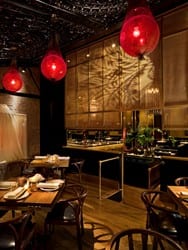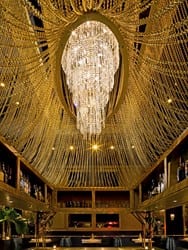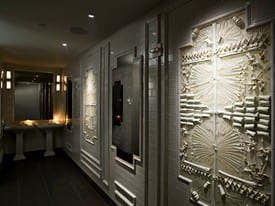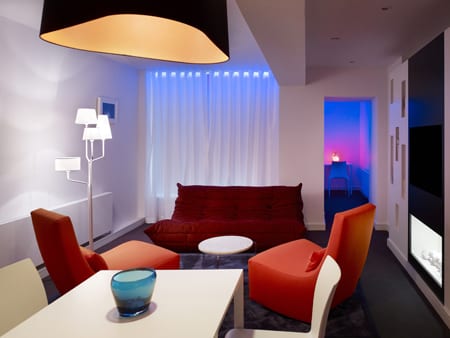 For his latest venture, Hurricane Club in New York, restaurateur Michael Stillman didn’t have to look far for a design firm-he went with longtime collaborator AvroKO, who designed his other two Manhattan restaurants, Quality Meats and Park Avenue. “Stillman has been our patron saint of New York restaurant design for a half a decade,” principals Kristina O’Neal, Adam Farmerie, Greg Bradshaw, and William Harris say.
For his latest venture, Hurricane Club in New York, restaurateur Michael Stillman didn’t have to look far for a design firm-he went with longtime collaborator AvroKO, who designed his other two Manhattan restaurants, Quality Meats and Park Avenue. “Stillman has been our patron saint of New York restaurant design for a half a decade,” principals Kristina O’Neal, Adam Farmerie, Greg Bradshaw, and William Harris say.
 For their largest project to date (the 13,000-square-foot space seats 350), Stillman had two directives for the designers: tiki (but not too tacky) and supper club. “We designed into those ideas as much as humanly possible,” they say.
For their largest project to date (the 13,000-square-foot space seats 350), Stillman had two directives for the designers: tiki (but not too tacky) and supper club. “We designed into those ideas as much as humanly possible,” they say.
Needing to create a flow that would allow for a series of rooms each with unique experiences and at the same time, an island concept, they quietly translated the geography of Gilligan’s Island into a program map that includes the Lagoon Lounge, the Volcano Room, and Cave Rooms. And appropriate rattan screens subtly separate the rooms.
.jpg) For actual material references, they were inspired by “Rat Pack-styled supper clubs and cheeky ’50s tiki lounges” with several abstracted animal references mixed in. There are gold-framed mirrors, butternut wood millwork, tables, and caning panels, brass hurricane lamps, faux-alligator finished banquettes, bone and barnacle chandeliers, and tiger and snake wallpaper. “You can’t have more animal fun than that,” they say. Other painstaking details AvroKO is known for include a black-and-white herringbone patterned marble floor and oversized white coral fireplace, and an elaborate golden hued chandelier fashioned out of cast glass and shells in the Lagoon Lounge; hand-sculpted high-gloss black lacquered ceiling panels resembling Polynesian-inspired lattice screens in the Cave Rooms; and walls covered in glossy red lacquer wood paneling and wallpaper reminiscent of Polynesian tattoo patterns in the Volcano Room.
For actual material references, they were inspired by “Rat Pack-styled supper clubs and cheeky ’50s tiki lounges” with several abstracted animal references mixed in. There are gold-framed mirrors, butternut wood millwork, tables, and caning panels, brass hurricane lamps, faux-alligator finished banquettes, bone and barnacle chandeliers, and tiger and snake wallpaper. “You can’t have more animal fun than that,” they say. Other painstaking details AvroKO is known for include a black-and-white herringbone patterned marble floor and oversized white coral fireplace, and an elaborate golden hued chandelier fashioned out of cast glass and shells in the Lagoon Lounge; hand-sculpted high-gloss black lacquered ceiling panels resembling Polynesian-inspired lattice screens in the Cave Rooms; and walls covered in glossy red lacquer wood paneling and wallpaper reminiscent of Polynesian tattoo patterns in the Volcano Room.
 In the center stands a massive gold chain and crystal chandelier, inspired by an actual hurricane/tornado form. “As the piece evolved it retained its key elements, but held the room better as a rectangular ‘hurricane.’ This is all part of not being too rigid with original design intent,” the designers explain.
In the center stands a massive gold chain and crystal chandelier, inspired by an actual hurricane/tornado form. “As the piece evolved it retained its key elements, but held the room better as a rectangular ‘hurricane.’ This is all part of not being too rigid with original design intent,” the designers explain.
But the feature they are most proud of? The European patterned bone panels that line the walls of the bathrooms. “They were fairly painstaking to create,” they say. “We handset over 2,000 bones of every shape and size into resin to create 12 distinct panels. It took a lot of experimentation (i.e., failures) to get these to shape up properly and read as elegant patterns.”
 And Riff Raff’s, the late-night venue adjacent to Hurricane Club, is composed of roughly 108 woven tapestries they sourced from small villages in Malaysia. “We literally had to travel to each village to talk with the locals and check out their wares in order to collect enough pieces to finish the project. In New York only replicas of these types of tapestries are made available but the effect of having so many of the crafted, handwoven pieces ensconce you in the space is breathtaking and worth the travel adventure to retrieve them.”
And Riff Raff’s, the late-night venue adjacent to Hurricane Club, is composed of roughly 108 woven tapestries they sourced from small villages in Malaysia. “We literally had to travel to each village to talk with the locals and check out their wares in order to collect enough pieces to finish the project. In New York only replicas of these types of tapestries are made available but the effect of having so many of the crafted, handwoven pieces ensconce you in the space is breathtaking and worth the travel adventure to retrieve them.”


